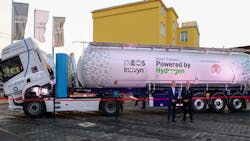U.K.-based vinyl chloride producer Ineos Inovyn plans to begin delivering PVC in a new hydrogen-powered truck beginning in the second quarter of next year in a move the company says will save 66 tons of CO2 annually.
The truck will deliver PVC from Inovyn’s production plant in Tavaux to Benvic’s PVC compound in Dijon.
Inovyn partnered with Benvic and leading industrial logistics company GCA Trans Service to produce the hydrogen truck, which will be built based on a DAF chassis in which the diesel motor will be replaced by hydrogen fuel cells. The truck, which will be refueled at a local station in Dijon providing 100% green hydrogen, has a range of 500 km (310 miles) between two refills.
“This is a historical moment for our company,” said Geir Tuft, CEO of Inovyn. “The use of hydrogen trucks for product deliveries is a key part of our sustainability roadmap, which aims to drastically reduce our CO2 footprint over the next few years. The Tavaux truck will be leading the way, and we have already planned similar projects with other customers in Benelux.”
Added Luc Mertens, CEO of Benvic: “This initiative between Benvic and Ineos Inovyn is a perfect fit with all our ESG actions, and also improves the environmental performance of our product. We work continuously to innovate our range of sustainable compounds in every way and logistics is a key factor, so we’re very proud to be one of the first Ineos Inovyn partners to engage in hydrogen-based technology for our deliveries.”
Customers and partners are welcome to join the initiative and work together with Inovyn to ensure CO2-free deliveries across sites, the company added.
“Supplying hydrogen to the transport market is a key step in our new Ineos hydrogen business strategy, which also includes new hydrogen production from water electrolysis, as well as hydrogen storage and development of downstream supply into chemicals,” Tuft said.
